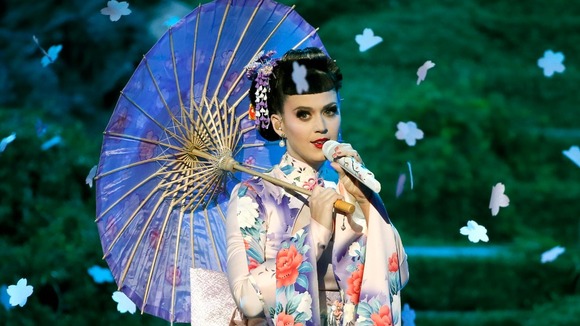Pop singer Katy Perry, who recently dressed as a geisha on stage, told Rolling Stone magazine that she doesn’t understand how her performance was racist.
There is a difference between appropriation and appreciation, although Katy Perry might not know it. In a recent interview with Rolling Stone, the pop singer reflected on criticism of a 2013 performance in which Perry dressed as a geisha on stage, noting:
“I guess I’ll just stick to baseball and hot dogs, and that’s it. I know that’s a quote that’s gonna come to f— me in the ass, but can’t you appreciate a culture? I guess, like, everybody has to stay in their lane? I don’t know.”
Katy Perry might not know, but I do. It might be a bit much to ask for Katy Perry to differentiate between appropriation and appreciation, but that is precisely what I am going to do now.
One need not be surprised by Katy Perry’s conflation of appropriation with appreciation, given her long and storied history as a pop act who relies on the watered down cultural artifacts of minority groups as a means of maintaining something resembling cachet.
This latest gaffe is consistent with Perry’s earlier projects, including dabbling in stage lesbianism in her inaugural single, “I Kissed a Girl,” and more recently, in her use of hypersexualized mummies with exaggerated derrieres and oversized earrings as backup dancers in this summer’s Prismatic Tour.
To be fair, Perry’s brand is also consistent with the wider world of popular music in these United States, in which young, white women (I’m looking at you, Miley Cyrus) coopt elements, artifacts, and products from cultures not their own. The phenomenon of cultural appropriation in popular music did not start with Ms. Perry, nor will it end with her. We have seen these same sorts of appropriative cultural production time and again; in the work of Gwen Stefani and her so-called “Harajuku” girls, in the earliest performances of Madonna, so quick to borrow from the black church (see: “Like a Prayer”) and the art of voguing, coopted from the ball culture by queer people of color in urban spaces beginning in the 1960s.
At the level of the lowest common denominator, we see this in the deployment of Native American cultural symbols, the donning of Indian headdresses for non-ceremonial purposes, recently banned at popular Canadian music festival Bass Coast, and in the sporting of the “geisha” look, as Ms. Perry did on stage in 2013. I deploy shock quotes around “geisha” because Katy Perry is no more a geisha than I am Captain America, and I think we all know this.
Though cultural appropriation is largely the provenance of white people—and certainly relies on the maintenance of a system of white privilege to remain operational—one need not be white to engage in appropriative acts. Nor, as critics might suggest, does my indictment suggest that white people are exempted from appreciation of other cultures.
What Ms. Perry and many of her compatriots fail to recognize, of course, is that there is a wide gulf between appreciation and appropriation. Linguistic similarities notwithstanding, appreciation and appropriation are distant cousins, not on speaking terms. Cultural appropriation is not tantamount to appreciation, it is deeply upsetting to many of those whose cultures are being coopted, and it is plainly racist.
Dressing in a politically incorrect costume for the sake of one’s performance might stem from a place of appreciation, but it is appropriative in its effect. And whatever the intention of Katy Perry’s various acts, intention never outweighs effect.
When, you might ask, is cultural appropriation okay? The answer is never. Cultural appropriation is never OK.
What Katy Perry does here is not appreciation. Appreciation can take many forms. It might entail admiring a cultural form or practice from some distance. It might encompass learning a language, visiting another culture, reading a book. It is respectful, it is enduring, and it is sustained. For a musician, appreciation may take the shape of learning a medium—Bonnie Raitt offers a clear and compelling example of this, as a white musician who has dedicated her entire life to the study, composition, and performance of the blues, an African American cultural form. That is appreciation.
By contrast, donning the ethnic garb of a cultural group not your own is cultural appropriation, plain and simple. In appropriation, the stylistic element of a cultural practice is retained, without any of its legitimacy or soul.
The distinction is clear, and it is obvious. But one need not be shocked. Based on the history, the only surprising element of Katy Perry’s easy dismissal of her own appropriation is that the pop star’s handlers aren’t doing a better job of circumventing these sorts of unfortunate incidences in the first place. A cynical observer might suggest that an element of intentionality is at work here. Katy Perry’s faux pas, cultural and otherwise, are arguably the very things that keep her relevant. And that is a sad indictment of our culture as much as a reflection on the missteps of one young pop singer.
Adina Giannelli’s writing has been featured in publications including Babble, Feministing, Salon and the forthcoming anthologies Book Lovers and Three Minus One Equals Zero.
Related Links:

